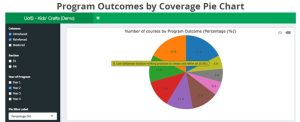Chapter 3 – Step 3 in the Process
Action 8: Map the Curriculum
Conduct curriculum mapping that is meaningful for key decisions
Curriculum mapping can be used to conduct an “inventory” of what exists in the current program that needs to be maintained and what gaps need to be addressed by the new program. “Mapping” suggests a graphic representation, but it can also be presented as a table. Whatever the summary format, a committee of experts then needs to assess what is represented and decide how to use the information.

You can also use a curriculum map when engaging in design and then presenting your new or revised program.
See the next pages for more on Curriculum Mapping and then Actions 9 and 10 on sequencing and approval levels.
Process Tips ✔
- Decide what information you most need to make good decisions about the curriculum. Curriculum mapping processes can sometimes become too extensive to be practical or timely.
- Refer to the curriculum alignment tool (curriculum mapping).
- Take opportunities to assess areas of shared university priority such as indigenization, internationalization, sustainability, wellness, or inclusion.
Good Signs! 🏁
Evidence of our understandings about current programming:
⊕ Student input is included since they are the people who experience the full curriculum
⊕ Curriculum mapping has informed decisions about what to do next
⊕ A summary document exists of curriculum mapping results
⊕ Opportunities are taken to assess areas like indigenization, wellness, inclusion, sustainability, and internationalization, among others
Warning Signs 🏴
⊗ No student input – or any student input was dismissed
⊗ Superficial or no attention to alignment
⊗ Curricular goals, practical requirements are not being actively and explicitly incorporated into discussions
⊗ No systematic assessment done on what can be kept or adapted from an existing curriculum
⊗ Curriculum mapping has become more elaborate and extensive than necessary, slowing the process

